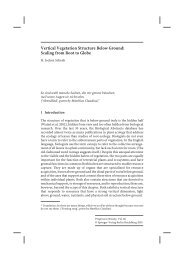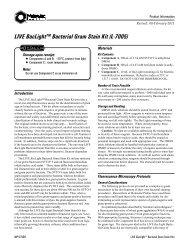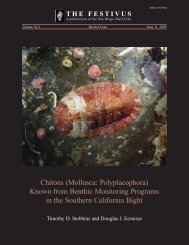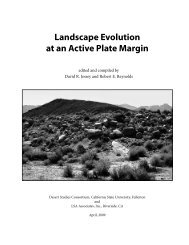2010 Overboard in the Mojave - Biological Science - California State ...
2010 Overboard in the Mojave - Biological Science - California State ...
2010 Overboard in the Mojave - Biological Science - California State ...
You also want an ePaper? Increase the reach of your titles
YUMPU automatically turns print PDFs into web optimized ePapers that Google loves.
held, derives its name from <strong>the</strong> Manix Union<br />
Pacific railroad sid<strong>in</strong>g (Fig. 2), 32 km east of<br />
<strong>the</strong> city of Barstow, San Bernard<strong>in</strong>o County,<br />
<strong>California</strong>.<br />
Latest Pleistocene and Holocene <strong>in</strong>cision<br />
by <strong>the</strong> <strong>Mojave</strong> River and local tributaries such<br />
as Manix Wash, have exposed a 120+ m-thick<br />
section of alluvial fan, playa, lacustr<strong>in</strong>e and<br />
fluvial sediments that records much of <strong>the</strong><br />
Pleistocene history of <strong>the</strong> central <strong>Mojave</strong><br />
River. Exposures <strong>in</strong> this area serve as <strong>the</strong> type<br />
localities for <strong>the</strong> Pliocene-Pleistocene <strong>Mojave</strong><br />
River Formation (Nagy and Murray, 1991),<br />
<strong>the</strong> middle to late Pleistocene Manix Formation<br />
( Jefferson, 1985a, 1994, 1999), and <strong>the</strong><br />
Camp Cady faunal assemblage (W<strong>in</strong>ters,<br />
1954; Howard, 1955; Jefferson, 1985b, 1987,<br />
1991a; Seiple, 1994).<br />
The upward-coarsen<strong>in</strong>g Pliocene-Pleistocene<br />
<strong>Mojave</strong> River Formation consists<br />
primarily of f<strong>in</strong>e-gra<strong>in</strong>ed sediments deposited <strong>in</strong> an <strong>in</strong>ternally<br />
dra<strong>in</strong>ed playa bas<strong>in</strong> (Nagy and Murray, 1991). These<br />
deposits rest on top of <strong>the</strong> late Miocene and Pliocene<br />
fanglomerates that <strong>in</strong>itially filled Manix bas<strong>in</strong>. With<strong>in</strong><br />
<strong>the</strong> Manix Formation, which overlies <strong>the</strong> <strong>Mojave</strong> River<br />
Formation, locally derived alluvial and fluvial sediments,<br />
and lacustr<strong>in</strong>e deposits largely transported by <strong>the</strong> ancestral<br />
<strong>Mojave</strong> River, appear to transgress/regress <strong>in</strong> consort<br />
with climate changes over <strong>the</strong> past 0.5 m.y. ( Jefferson,<br />
1985a, 1994, 1999).<br />
The assemblage of <strong>in</strong>vertebrate and vertebrate fossils<br />
recovered from eroded river bluffs and badlands of <strong>the</strong><br />
Manix Formation dates from ca. 350 ka to 20 ka, and<br />
<strong>in</strong>cludes ext<strong>in</strong>ct and extralocal extant taxa that reflect a<br />
more equable climate and diverse biogeographic sett<strong>in</strong>g<br />
than at present (Buwalda, 1914; Merriam, 1915; W<strong>in</strong>ters,<br />
1954; Howard, 1995; Jefferson, 1985a, 1985b, 1987,<br />
1991a; Jefferson and Ste<strong>in</strong>metz, 1986; Ste<strong>in</strong>metz, 1987,<br />
1988; Seiple, 1994).<br />
The follow<strong>in</strong>g discussion is an amended syn<strong>the</strong>sis of<br />
previous studies. It provides a summary of <strong>the</strong> stratigraphy<br />
and depositional history of <strong>the</strong> Manix Formation,<br />
and a brief discussion of deposits and events relevant to<br />
<strong>the</strong> history of Lake Manix and <strong>the</strong> paleohydrology of <strong>the</strong><br />
<strong>Mojave</strong> River. Also <strong>in</strong>cluded is an analysis of <strong>the</strong> fossil<br />
assemblage recovered from Lake Manix and its paleoenvironmental<br />
significance ( Jefferson, 1987).<br />
Pliocene-Pleistocene Stratigraphy<br />
Basement rocks exposed around <strong>the</strong> marg<strong>in</strong>s of Manix<br />
bas<strong>in</strong> are primarily pre-Cenozoic metamorphic rocks<br />
george t. jefferson<br />
Figure 3. <strong>Mojave</strong> River Formation. The view is to <strong>the</strong> northwest from<br />
approximately 1 km east of <strong>the</strong> confluence of Manix Wash and <strong>the</strong><br />
<strong>Mojave</strong> River. Gypsum-cemented pale gray-green siltstones and<br />
claystones form <strong>the</strong> more resistant horizons (also see exposures <strong>in</strong> midimage<br />
of Fig. 5). Note geologist for scale.<br />
and Tertiary volcanic and volcaniclastic deposits (Beyers,<br />
1960; Bassett and Kupfer, 1964). The oldest fill with<strong>in</strong> <strong>the</strong><br />
bas<strong>in</strong> consists of <strong>the</strong> late Miocene and Pliocene fanglomerates<br />
(older fanglomerate unit of Nagy and Murray,<br />
1991; granitic fanglomerate of Meek and Battles, 1991).<br />
These fanglomerates are overla<strong>in</strong> by Pliocene-Pleistocene<br />
playa and fluvial sediments of <strong>the</strong> <strong>Mojave</strong> River Formation<br />
(Nagy and Murray, 1990, 1991). These units, <strong>in</strong> turn<br />
are usually overla<strong>in</strong> unconformably by fanglomerates,<br />
alluvial, fluvial, and lacustr<strong>in</strong>e sediments of <strong>the</strong> middle to<br />
late Pleistocene Manix Formation (Buwalda, 1914; Ellsworth,<br />
1933; Blackwelder and Ellsworth, 1936; W<strong>in</strong>ters,<br />
1954; Jefferson, 1985a, 1994, 1999; Bud<strong>in</strong>ger, 1992).<br />
Late Wiscons<strong>in</strong> and Holocene fluvial sediments (Hagar,<br />
1966; Groat, 1967; Meek, 1990) both cap and are <strong>in</strong>set<br />
<strong>in</strong>to <strong>the</strong> older sedimentary sequence.<br />
<strong>Mojave</strong> River Formation, ca. 2.5–1 Ma<br />
The <strong>Mojave</strong> River Formation consists primarily of<br />
gypsiferous, reddish-tan and light gray-green claystones<br />
and siltstones that total >80 m <strong>in</strong> thickness (Nagy and<br />
Murray, 1991) (Fig. 3). The base of this upward-coarsen<strong>in</strong>g<br />
sequence is not exposed <strong>in</strong> <strong>the</strong> type area, near <strong>the</strong><br />
confluence of Manix Wash and <strong>the</strong> <strong>Mojave</strong> River (Fig.<br />
2). However, 4 km to <strong>the</strong> east, <strong>the</strong>se deposits overlie a<br />
30+ m-thick section of fanglomerates (older fanglomerate<br />
unit of Nagy and Murray, 1991) that are exposed on<br />
<strong>the</strong> upthrown, north side of <strong>the</strong> Manix fault (Keaton and<br />
Keaton, 1977; McGill et al., 1988) (Fig. 4). To <strong>the</strong> south,<br />
toward <strong>the</strong> Cady Mounta<strong>in</strong>s, <strong>the</strong> deposits grade up section<br />
<strong>in</strong>to f<strong>in</strong>e to coarse-gra<strong>in</strong>ed lithic arenites and granule<br />
to cobble conglomerates.<br />
In <strong>the</strong> most nor<strong>the</strong>rn exposures, <strong>the</strong>se deposits are<br />
40 <strong>2010</strong> Desert Symposium
















